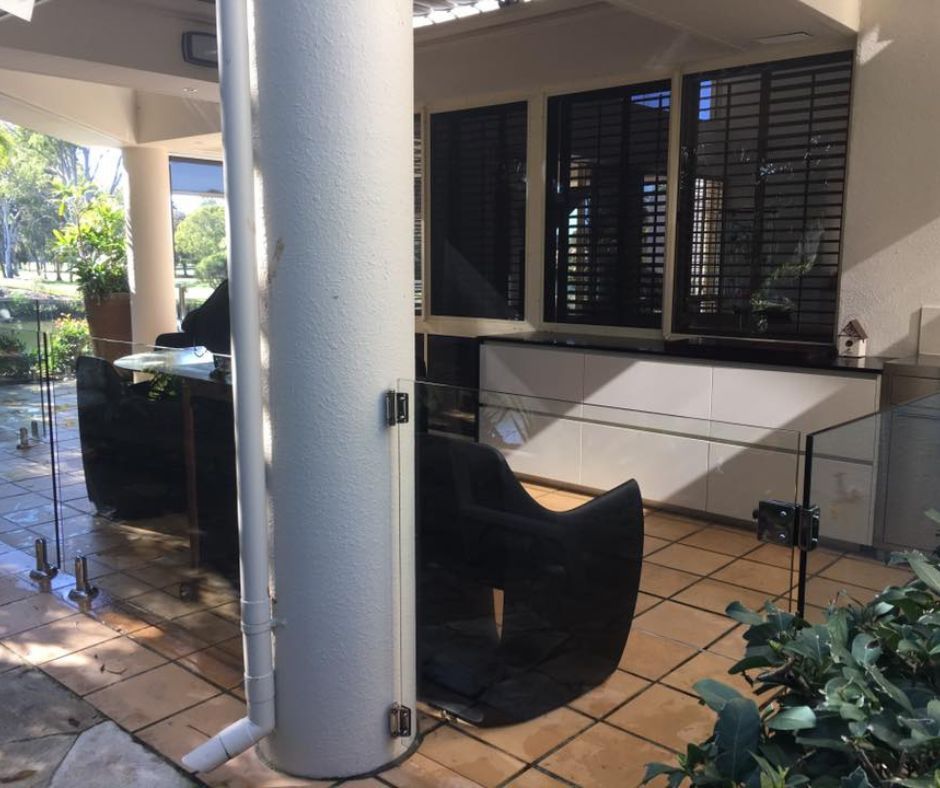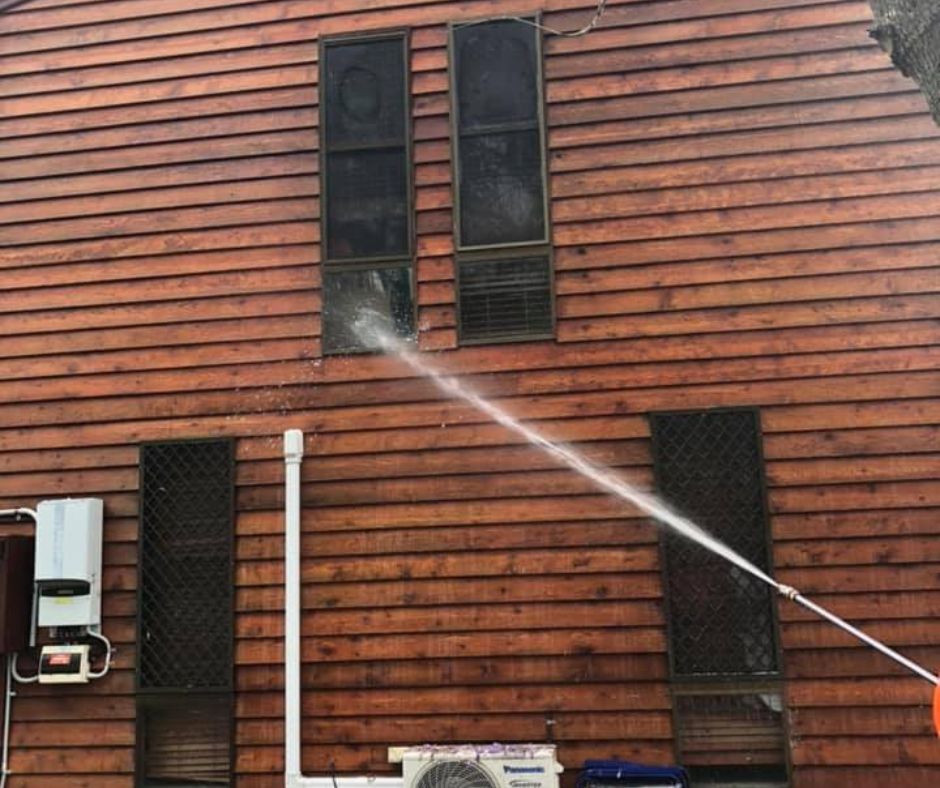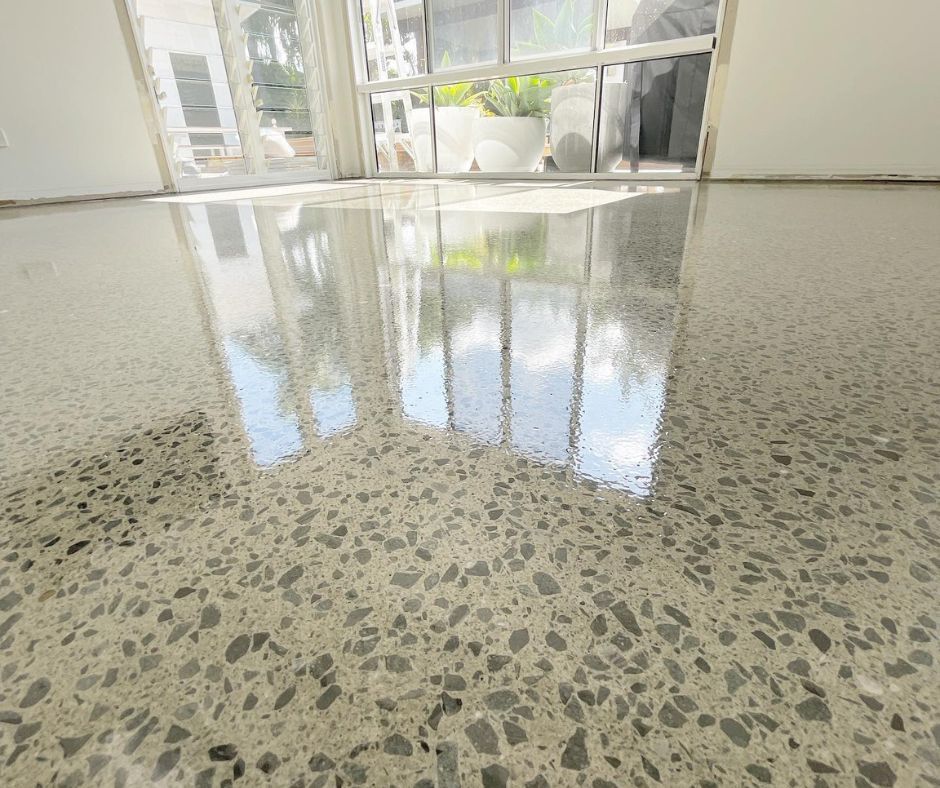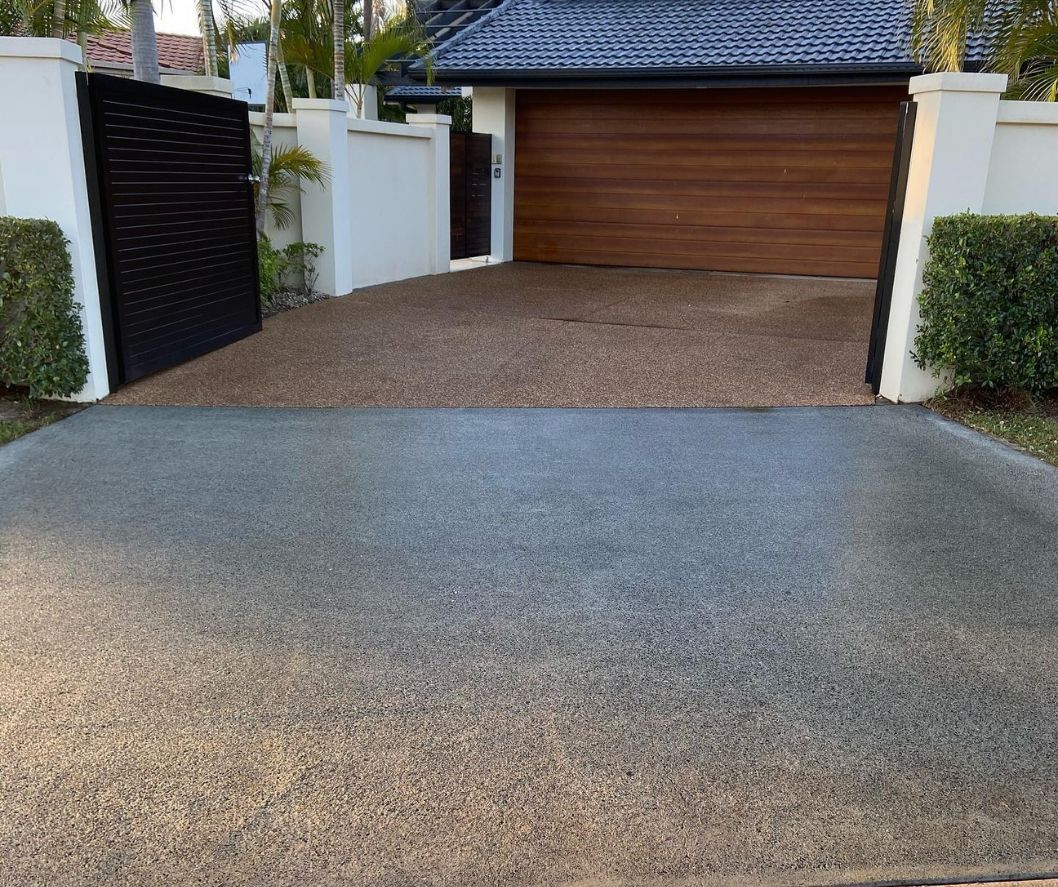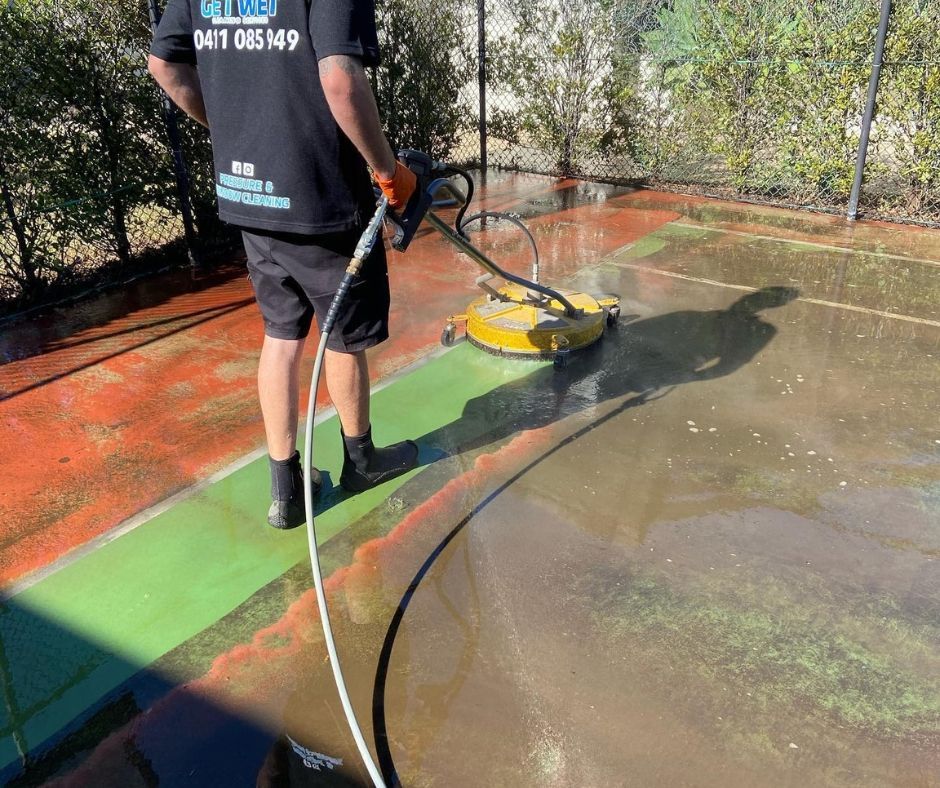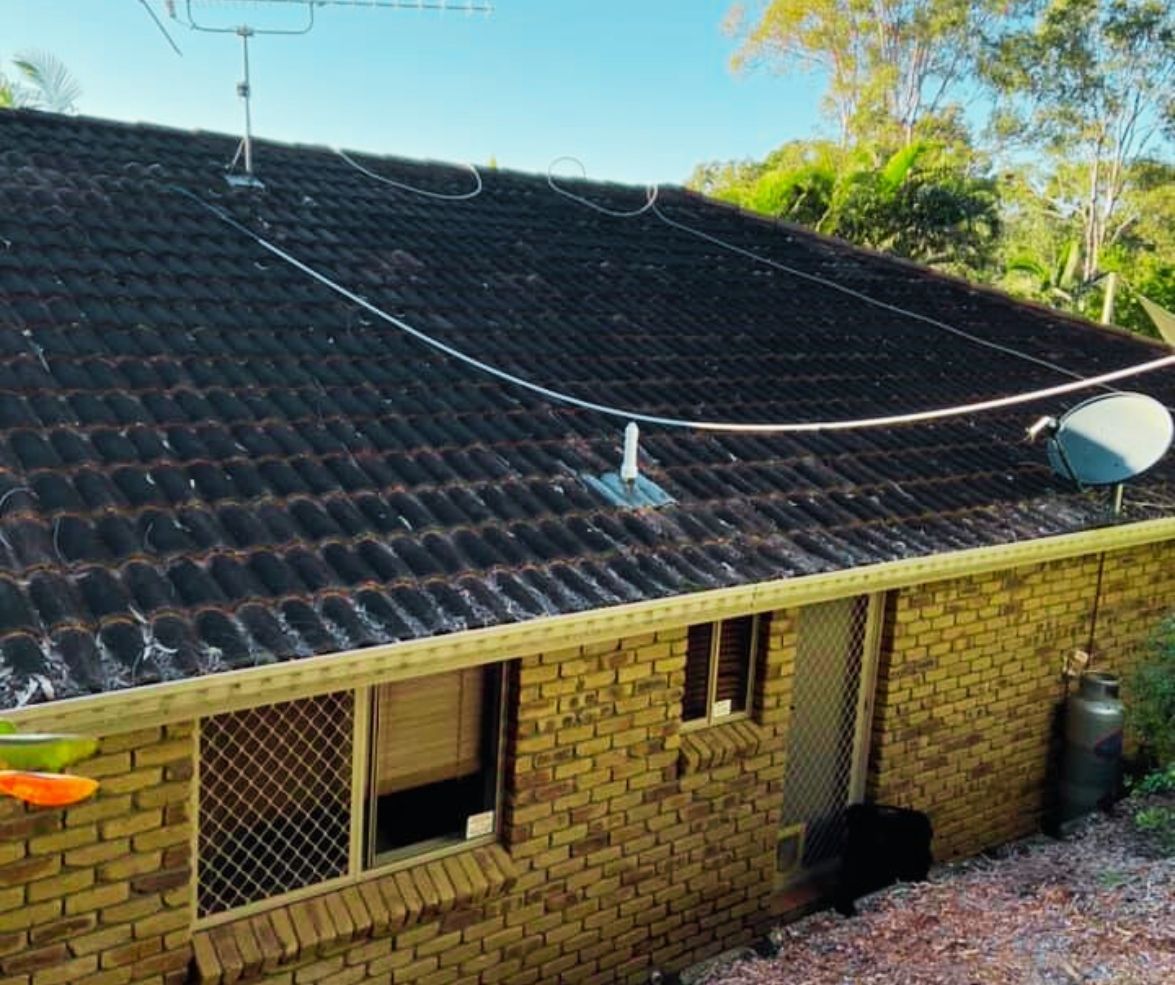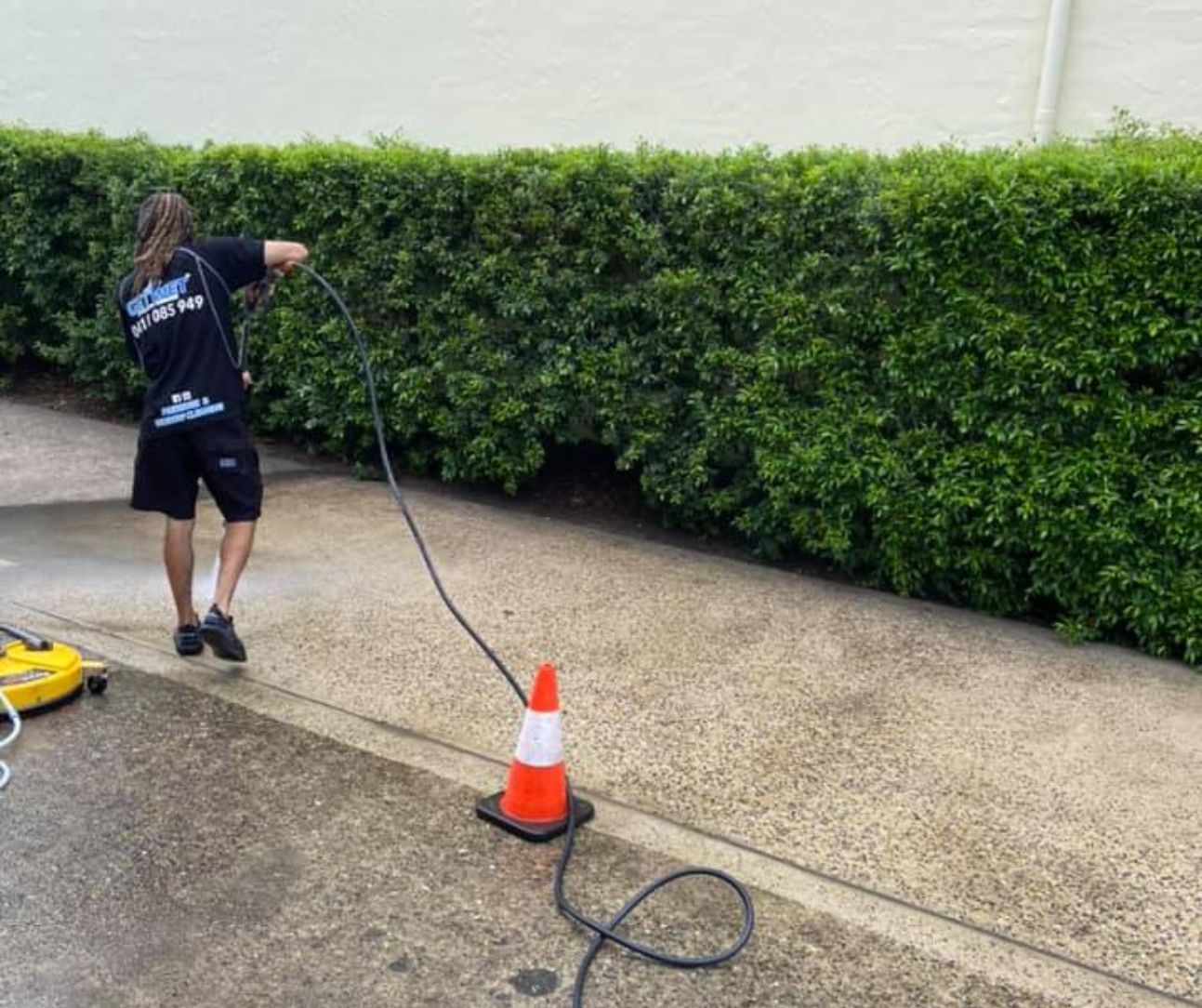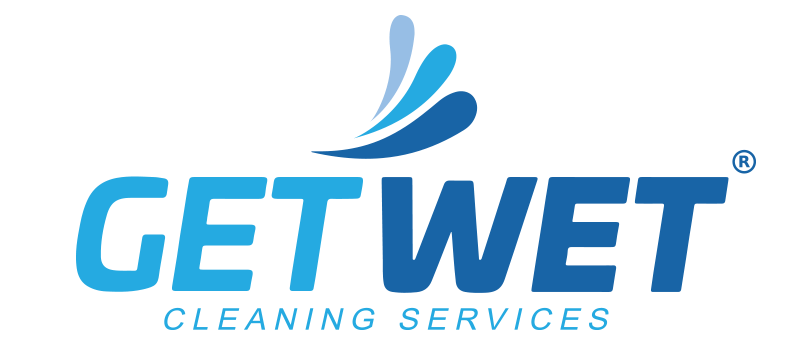The Homeowner's Expert Guide to Pressure Washing
If the exterior of your place is starting to look tired, grubby walls, a green sheen on the driveway, black mould spots on the patio, you’re not alone. This guide to pressure washing is for Gold Coast homeowners, landlords, property owners and anyone who wants a safer, smarter way to bring back curb appeal without damaging surfaces.
We’ll cover what pressure washing is, when to do it, how to do it safely, what it costs in broad terms and why it pays to get professional help, especially on those tricky and delicate spots. Expect straight talk on common pollutants of exterior surfaces, tips for avoiding damage and a clear rundown of the major benefits of exterior pressure washing on the Gold Coast.
By the end, you’ll have a practical guide to pressure washing, step-by-step checklists, safety pointers and the right method for each surface and tailored to Gold Coast local conditions, so you can protect both your property and the environment.
Table of Contents
2. How Often Should You Pressure Wash Your House
2.1 What Drives Frequency
2.2 Seasonal Sweet Spots
2.3 Areas That May Need Different Schedules
2.4 A Quick Maintenance Checklist
3. Benefits of Pressure Washing
4. How Much Does Pressure Washing Cost in Australia
4.1 What Actually Drives the Price
4.2 Why “Cheapest” Can Actually Cost More
5.1 What is Soft Washing?
5.2 What is Power Washing?
5.3 Soft Wash vs Power Washing: Which One Should You Choose?
5.4 Environmental Considerations
6. What is PSI and GPM in Pressure Washing?
6.1 PSI Explained: Pounds per square inch
6.2 GPM Explained: Gallons per minute
6.3 How Pressure Washer PSI and GPM Work Together
6.4 Tips for Selecting a Machine Based on Pressure Washer PSI and GPM
7. Does Pressure Washing Affect Curb Appeal and Home Value?
7.1 What is Curb Appeal and Why It Matters
7.2 How Curb Appeal Pressure Washing Helps
7.3 Curb Appeal Pressure Washing Impact on Home Value
8. Can You Clean Windows With a Pressure Washer?
8.1 Risks to be Aware of
8.2 How Pros Do It Safely
8.3 When Professional Window Washing Makes Sense
9. How to Clean a Driveway With a Pressure Washer
9.1 How to Clean a Driveway With a Pressure Washer: The Pro Way
9.2 Why Hire Professionals for Driveway Pressure Cleaning
9.3 Risks of DIY and Safety Tips
9.4 How Often Should a Driveway Be Cleaned in the Gold Coast
10. How to Clean a Roof With a Pressure Washer
10.1 Soft Washing vs Pressure Washing for Roofs
10.2 Roof Types and Pressure Suitability
10.3 Key Professional Techniques
10.4 Why Not DIY?
10.5 Maintenance & Timing
11. Can You Clean Decking with a Pressure Washer?
11.1 Deck Types that Benefit from Professional Pressure Cleaning
11.2 Consequences of Getting It Wrong
11.3 Why Professional Cleaning Beats DIY on Deck Pressure Washing
12. How to Clean Wooden Decking with a Pressure Washer
12.1 Why Wood Needs a Gentler Approach
12.2 The Pro Method: Soft Wash or Low Pressure
12.3 Benefits of Hiring a Pro for Deck Pressure Cleaning
12.4 Best Time for Professional Deck Pressure Cleaning
13. How to Clean a Fence with a Pressure Washer
13.1 Different Fence Materials and Cleaning Approaches
14. Can You Pressure Clean Petrol Stations?
14.1 Why Service Stations Need Special Care
14.2 Challenges in Petrol Station Pressure Cleaning
14.3 Equipment & Cleaning Methods
14.4 Benefits of Professional Petrol Station Pressure Cleaning
15. Pressure Washer Safety Tips & Considerations
15.1 Common Pressure Washing Hazards
15.2 Pressure Washer Safety Tips Before You Start
15.3 Safe Operating Practices
15.4 Environmental and Property Protection
16. Tips on Pressure Washing: What Not To Do
16.1 Common Tips on Pressure Washing that Need to be Avoided
16.2 How to Avoid These Mistakes
16.3 The Importance of Knowing Mistakes and Tips on Pressure Washing
16.4 When Should You Call In a Professional
17. Is Bleach Good for Pressure Washing?
17.1 Understanding Bleach in Exterior Cleaning
17.2 Can You Run Bleach Through a Pressure Washer
17.3 When is Bleach Recommended
17.4 Best Practices in Pressure Cleaning with Bleach
17.5 So… Is Bleach Good For Pressure Washing?
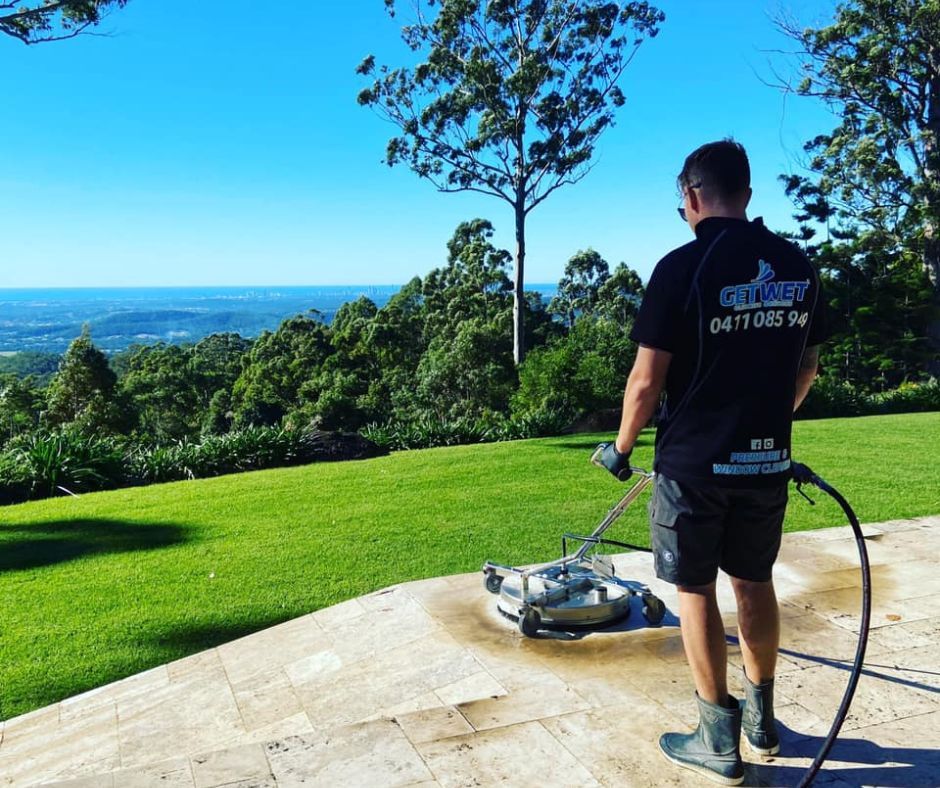
What Is Pressure Washing
At its simplest, what is pressure washing?
It’s the use of high-pressure water to remove dirt, mould, algae, grime and stains from exterior surfaces. Think driveways, paths, retaining walls, pool surrounds, brick, render and more. The pressure and water flow combine to blast contaminants out of pores that scrubbing can’t reach. This method of cleaning is perfect for concrete, pavers and stone, especially on the Gold Coast, where sea spray and humidity feed organic growth. There are also plenty of interesting facts about pressure washing, from its surprising efficiency to how different pressure levels suit different materials, which makes it one of the most versatile cleaning methods around.
You’ll also hear power washing used in many conversations. If you’re wondering what is pressure washing and its difference from power washing, both of them are used interchangeably, but technically, power washing refers to using heated water. Hot water can help with oily or greasy stains, like on the garage floors, because heat breaks down contaminants faster.
Not every surface likes brute force, and this is why soft washing is often the ideal solution. Soft Washing is a low-pressure, high-coverage method paired with appropriate cleaning detergents. It’s the safer play for painted exteriors, cladding, weatherboards, windows, screens and delicate render.
On a typical Gold Coast home, a professional cleaner will combine methods,
soft wash for the house wash itself,
high-pressure cleaning for the driveway and paths and a
careful washing approach for the windows, which is a practical answer to what is pressure washing across different surfaces.
How Often Should You Pressure Wash Your House
So, how often should you pressure wash your house on the Gold Coast? As a general rule, plan a full exterior house washing 1–2 times a year. The humid, coastal conditions encourage mould and algae, homes near trees cop with more pollen and sap and places right by the beach see salt film build-up on glass and balustrades. Add in summer storms and you’ve got perfect conditions for slippery paths and black spotting on concrete.
What Drives Frequency
- Climate & micro-climate:
- High-humidity suburbs or canal-side homes (Hope Island, Runaway Bay, Mermaid Waters) tend to need more frequent cleans than breezy, elevated pockets.
- Vegetation & shade:
- Overhanging trees, hedges and shaded sides of the house collect spores and hold moisture.
- Coastal exposure:
- Salt spray accelerates grime on glass, stainless and painted finishes.
- Use & traffic:
- Pets, prams, bikes and cars track dirt and oils onto driveways and entries.
- Surface type:
- Porous concrete and pavers hold onto grime, while painted/weatherboard surfaces prefer gentle, more regular soft washes.
Seasonal Sweet Spots
When it comes to the right frequency of pressure washing your house, aligning the job with the right seasons is the most effective approach, as each brings its own pros and cons.
Autumn
After summer’s high humidity and frequent storms, sea spray and sunscreen residue, exterior surfaces are salty, sticky and primed for mould. A thorough wash during autumn removes that buildup before the cooler, damper months set in, helping prevent stains and slippery growth over winter.
Spring
Winter leaves behind mould, pollen and fine dust, especially on shaded paths and façades. Pressure cleaning during spring refreshes the exterior for the entertaining season and gives paint, sealers and decks a clean surface to perform their best.
Areas That May Need Different Schedules
Driveways & paths:
These high-traffic areas collect tyre marks, oil, dirt and black mould that make surfaces look dull and slippery. Clean them every 6–12 months and more often if they sit under trees or stay shaded and damp. Regular driveway pressure cleaning keeps the texture grippy and helps sealers last longer.
Walls & eaves (soft wash):
Façades pick up dust, cobwebs, salt film and mildew, especially on the southern side and near the coast. Plan a gentle soft wash annually or a lighter touch every 6–9 months in high-humidity pockets. Low pressure protects delicate paints and finishes, seals, vents and window frames.
Roof cleaning:
Roofs harbour lichen, algae and leaf stains, and cleaning improves both appearance and efficient water flow on gutters. Schedule professional roof washing every 1–2 years, sooner if you have overhanging trees or heavy sea spray.
Pool surrounds & decks:
Splash, sunscreen and shade feed algae that can turn pavers and timber slick. Clean these areas around
every 6 months to reduce slip risk and keep the space guest-ready. Pros will use deck-safe cleaning solutions and low pressure to protect fibres and finishes.
A Quick Maintenance Checklist
Here’s a simple checklist you can follow yourself to check on how often should you pressure wash your house:
- Walk the property each change of season. Look for green/black patches, especially on the southern side and under eaves.
- Rinse salt film on coastal glass balustrades monthly.
- Trim back overhanging branches and blow leaves off paths to keep surfaces drier.
- Book professional help for high, complex or delicate areas, particularly on roofs and multi-storey façades.
The answer to "How often should you pressure wash your house?" is greatly affected by these two main factors: local climate and the type of surfaces. Having a grasp of these factors helps you set a sensible schedule and approach to different types of surfaces. It’s always best to consult a professional cleaning service on the Gold Coast to keep your home looking sharp year-round while protecting its materials, coatings and surrounding landscaping.
Benefits of Pressure Washing
A well-executed exterior clean provides a lot of advantages, and not just to make your place sparkle. For Gold Coast properties, where humidity, salt-laden air and summer downpours feed mould and grime, the benefits of pressure washing show up not only at open homes but also in day-to-day living.
Aesthetic Improvements
The benefits of pressure washing are obvious here. It removes grime on driveways, tyre shadows, cobwebs and salt haze on façades, restoring the true colour of your property.
Increased Property Value
Agents regularly recommend a full wash before photography and inspections because it sharpens kerb appeal, signals a “well-maintained” property and broadens buyer interest, particularly in coastal suburbs where salt and mildew age surfaces prematurely. This is one of the benefits of pressure washing when preparing a home for sale.
Preventative Maintenance
Left alone, algae, mould and mildew trap moisture against paint, timber and mortar, accelerating decay, stains and spalling. Routine washing clears contaminants before they create damage, extending the life of coatings, wood and concrete sealers, and substrates. In high-traffic areas (entries, driveways, pool surrounds), that also means fewer slips and fewer urgent fixes.
Health Benefits
Removing mould, pollen and dust from outdoor living areas improves air quality. With fewer airborne irritants right at the entry points, families (especially allergy and asthma sufferers) breathe easier and experience fewer flare-ups. It also reduces musty odours and helps keep interior surfaces cleaner for longer.
Cost Savings Over Time
Regular exterior care is cheaper than premature repainting or surface repairs caused by long-term neglect. Pros work faster with commercial machines and surface cleaners, so you get an even finish, no missed patches and less downtime around the property.
Eco-friendly Options
Eco-friendly cleaning means using detergents that break down quickly and don’t leave harmful residues on your garden or hardscapes. Professionals choose biodegradable solutions at the right dilution, then control where the dirty water goes.
Perfect Prep for Painting or Renovation
Fresh coatings need clean, sound substrates. Pre-painting
soft-wash on walls and a
pressure clean on hardscape strips contaminants so primers bond properly and sealers cure evenly. Surface prep is one of the practical benefits of pressure washing, helping coatings last longer and look better.

How Much Does Pressure Washing Cost in Australia
Wondering how much does pressure washing cost in Australia?
Short answer: it depends! No two homes, driveways or roofs are alike. There are a lot of factors influencing the final price of a pressure cleaning service on the Gold Coast. Use this guide to unpack the real drivers of how much does pressure washing cost in Australia and to compare itemised quotes on value, safety and results, not just price.
What Actually Drives the Price
- Size of the area: Spaces with a larger square metre take longer to prep and clean, use more water and often need multiple passes with a pressure washer.
- Surface type: Different materials (porous concrete, pavers, roofing, render, timber) require specific nozzles, pressures and techniques to avoid damage.
- Condition: Heavily soiled or long-neglected surfaces need pretreatment chemicals and longer cleaning time, increasing labour and materials.
- Accessibility: Heights, steep or narrow areas and multi-storey façades demand specialised equipment and height-safety measures that add cost.
- Method: Whether it’s soft washing, high pressure washing or power washing dictates the equipment, consumables and labour intensity.
- Local rates & demand: Quotes reflect Gold Coast market rates, travel time and the contractor’s insurances, training and professional-grade equipment.
Why “Cheapest” Can Actually Cost More
Low-ball quotes often skip pretreatments, runoff control or use the wrong pressure. That can cause striping, etched concrete, blown window seals and landscape damage, exactly why how much does pressure washing cost in Australia shouldn’t be judged on price alone. Any upfront saving quickly disappears if you need re-cleaning, stain removal or repainting to repair mistakes.
DIY vs. Hiring a Professional
DIY Pros:
- Lower upfront spend for small, simple, flat areas.
- Full control over timing and pace.
- Handy for quick touch-ups between professional cleans.
DIY Cons:
- Costly if you need to purchase your own pressure washer.
- Risk of gouging timber, etching concrete, blowing window/door seals or unsafe ladder work.
- Limited equipment (low GPM/PSI, no surface cleaner, no soft-wash setup) means slower, patchier results.
- No wastewater plan or knowledge of local stormwater rules.
- Chemical handling and dilution errors can damage plants, coatings and hardware.
- Personal liability if you injure yourself or others.
Pro Advantages:
- Professional-grade machines and surface cleaners deliver faster, more even results.
- Correct PSI/flow/nozzle and cleaning agents matched to each surface (including soft wash for delicate surfaces).
- Proper containment of runoff, eco-safe products and compliance with local regulations.
- Height safety, insurance and trained operators reduce your risk.
- Advice on maintenance schedules and sealing to extend the clean.
Pro Disadvantages:
- Higher upfront cost than DIY.
A pro tip, if you’re comparing quotes for how much does pressure washing cost in Australia, ask for an itemised scope (areas, method, pretreatments, etc) so you’re comparing like-for-like.
Soft Wash vs Power Washing
What is Soft Washing?
Soft washing is a low-pressure clean that pairs water with eco-friendly detergents to lift stubborn growth (algae, mould, mildew) and built-up dirt and grime without abrasion and prevent regrowth.
It’s ideal for painted façades, weatherboard/cladding, windows, screens, delicate render and most roofing materials.
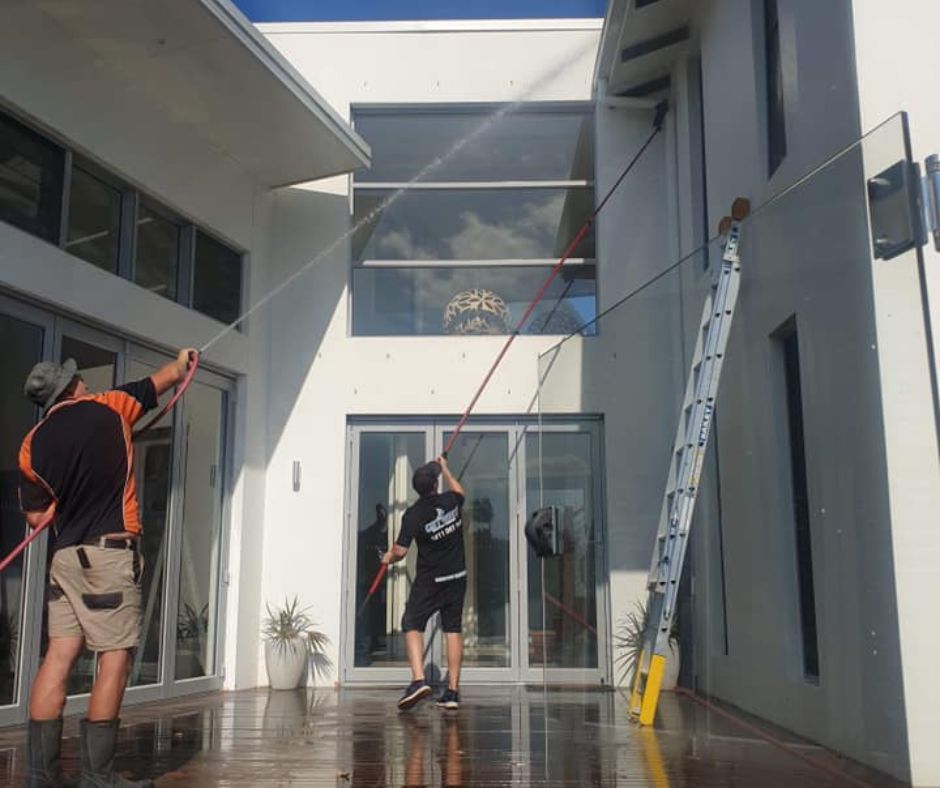
What is Power Washing?
Power washing (often used interchangeably with “pressure washing”) relies on higher pressure. In trade contexts, “power” can also mean adding heat for oily and stubborn stains.
It’s the go-to for durable surfaces and hardscapes, such as driveways, concrete, pavers and masonry.
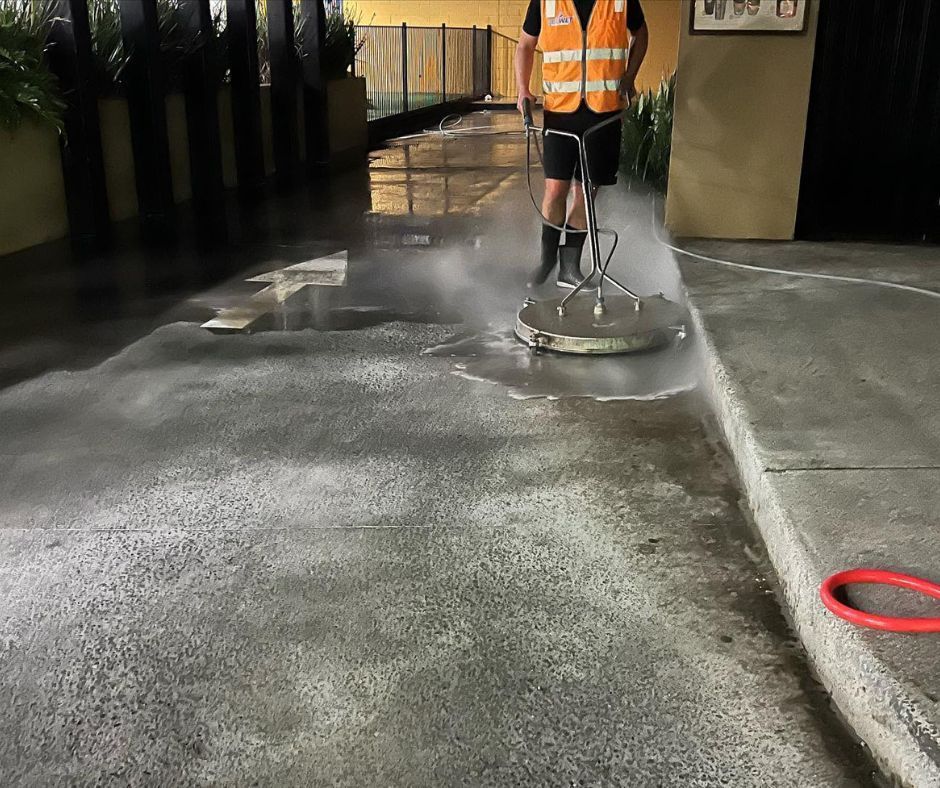
Soft Wash vs Power Washing: Which One Should You Choose?
Not sure which surface should use, soft wash vs power washing? Use this quick guide to choose the right approach for a longer-lasting finish without damage.
| Surface | Recommended Method | Why |
|---|---|---|
| Painted walls, cladding, windows | Soft wash | Protects coatings, avoids water ingress into seals. |
| Roofs (tile/Colorbond) | Mostly soft wash | Minimises risk to tiles/flashing, aligns with metal coating care. |
| Driveways, concrete, pavers | Power wash | Pairs higher PSI + surface cleaner for even, streak-free results. |
| Timber decks & fences | Soft/very low pressure | Prevents furring/gouging. |
Environmental Considerations
Environmental care sits at the heart of soft wash vs power washing. Pros choose biodegradable, surface-appropriate detergents and apply them at the right dilution to protect landscapes and use controlled flow so runoff doesn’t carry contaminants into drains.
Local rules generally prohibit letting contaminated runoff enter stormwater, so a clear wastewater plan matters. The right approach, between soft wash and power wash, delivers a clean exterior without harming waterways or landscaping.
What is PSI and GPM in Pressure Washing?
If you’ve ever compared pressure washers, you’ve seen two numbers everywhere: PSI and GPM. Together, pressure washer psi and gpm tell you how much force hits the surface and how much water carries the grime away. Think of PSI as the “break-up power” and GPM as the “rinse speed”. You need both in balance for a faster clean without damage.
PSI Explained: Pounds per square inch
PSI describes the pressure at the nozzle as the force that breaks up stubborn grime, grease, algae and tyre marks. Higher PSI helps on hard surfaces like concrete, but too much pressure on delicate materials (painted walls, timber, soft render) can etch, strip or splinter.
GPM Explained: Gallons per minute
GPM measures water flow. The volume that actually lifts and flushes debris off the surface. More flow speeds up large-area jobs (driveways, patios) and leaves fewer streaks because you’re not “dragging” dirty water. Low GPM can make a high-PSI machine feel slow, because you’ll loosen soil but spend ages rinsing. Adequate flow also keeps surface cleaners spinning smoothly for that even, swirl-free finish.
How Pressure Washer PSI and GPM Work Together
Think of force (PSI) and volume (GPM) as a team, both matter for an even, effective clean. Professionals balance pressure washer PSI and GPM for each substrate and compare machines using Cleaning Units (CU = PSI × GPM), but the technique used, steady passes and appropriate cleaning agents are still important factors to deliver an even, effective clean without scarring surfaces or forcing water into joints.
Understanding pressure washer PSI and GPM helps set the right expectations for professional-quality finish and speed.
Tips For Selecting a Machine Based on Pressure Washer PSI and GPM
Here’s a plain guide to using pressure washer PSI and GPM when picking gear.
Prioritise balance over big numbers
A balanced setup beats a sky-high PSI. You also need enough water flow (GPM) so the rinse carries muck away.
Match it to the job
Walls and window washing like lower PSI with good flow, driveways and pavers often need moderate to higher PSI and roofs are usually a gentle wash (low pressure with detergent).
Think about size
On big areas, more GPM gets the job done quicker and helps avoid stripy results.
Ask “how will you clean it?” not just specs
If you’re hiring a pro, ask what PSI/GPM they’ll use on each surface and why, clear answers show they truly understand pressure washer PSI and GPM.
Does Pressure Washing Affect Curb Appeal and Home Value?
What is Curb Appeal and Why It Matters
Curb appeal is that street-view first impression, what buyers or guests feel before they step inside. Clean lines, sharp colour, and tidy hardscapes signal “well cared for” and nudging people to look closer.
Curb appeal pressure washing focuses on the high-impact zones that frame those first impressions, such as the driveway and paths, front façade, fence line, porch and garage door.

How Curb Appeal Pressure Washing Helps
Here’s how curb appeal pressure washing delivers quick, visible wins in the places people notice first.
Driveway & Paths
Oil spots, tyre marks, dirt and algae are blasted away to reveal a clean, even surface that frames your home beautifully. Clear, bright concrete or pavers also make landscaping pop and guide the eye to your entry.
Front Façade & Eaves
A gentle, low-pressure soft wash removes dust, cobwebs, mildew and soot without damaging paint, render or delicate trims, restoring colour and crisp lines around façade, windows and eaves.
Fences & Gates
Exterior pressure washing strips off grime, mould and weathering so timber and metal look cared-for and secure. Clean boundary lines lift the whole streetscape and can extend the life of paint or sealers.
Garage Door & Letterbox
These surfaces are eye-level and high-impact, so a quick clean pays off. Removing streaks and film unifies colour and makes the entry feel newer.
Decks & Pool Surrounds
Built-up algae, dirt residue and food spills are removed to restore the natural tone of timber or stone. A clean, non-slip surface looks inviting and safer for bare feet around entertaining areas.
Windows
Crystal-clear glass is an instant curb-appeal booster, sharpening reflections from the street and letting more natural light into your home. A careful window soft wash lifts dust, hard-water spots and insect marks from panes, frames and screens.
Curb Appeal Pressure Washing Impact on Home Value
Presentation shapes buyer interest and price confidence. When exteriors are spotless, people assume the inside has been looked after too. While exact uplift varies by market, agents consistently recommend a professional exterior clean before photography and open homes because it improves light, colour accuracy and overall harmony.
For owners not selling, the benefit is durability. Clean, dry surfaces outlast dirty ones, reducing repainting and resurfacing needs over time. In short, curb appeal pressure washing is a cost-effective and efficient way to boost perceived value, widen buyer appeal and protect the asset you already have.
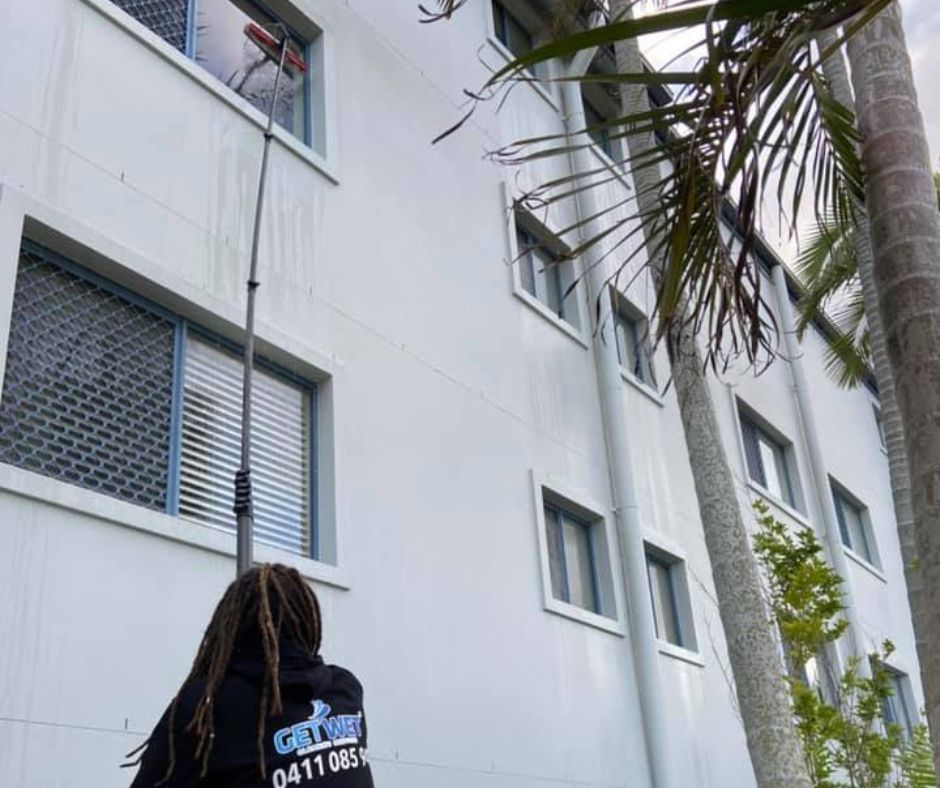
Can You Clean Windows With a Pressure Washer
Our clients often ask, "Can you clean windows with a pressure washer?" Technically yes, but it’s a specialist task best left to trained operators using low-pressure soft-wash for windows or purified-water pole systems. High pressure on glass risks micro-cracks, seal failure and water forced into frames, especially on older aluminium sliders or timber sashes common in coastal homes.
Risks to be Aware Of
- Glass breakage & scratches: Narrow nozzles combined with excessive PSI can concentrate force on a small area, chipping edges or scratching tempered glass.
- Compromised seals: High-pressure jets can lift caulking and rubber gaskets, creating leaks and window fogging over time.
- Ingress into frames/walls: Water driven past weep holes can soak wall cavities and insulation, leading to damp, mould and hidden damage.
How Pros Do It Safely
Can you clean windows with a pressure washer? In professional hands, it’s possible, see how below.
Soft washing
Professionals apply a detergent pre-spray and rinse at low pressure, shielding edges and seals to clean without mechanical stress.
Filtered-water poles
Professional team uses filtered (deionised) water that dries spot-free, allowing safe cleaning of upper storeys without harsh chemicals or close contact.
Controlled angles & distance
Wide-spray tips and steady, shallow-angle passes keep water out of frames while still effectively removing grime.
When Professional Window Washing Makes Sense
Wondering if you can clean windows with a pressure washer? Technically yes, but it’s best done by professionals. Use the points below to see when it’s worth booking a specialist.
Second-storey or Hard-to-reach Glass
Working at height introduces fall risks and awkward angles that can crack panes or flood frames if handled poorly. Professionals use height-safe equipment and controlled, low-pressure methods to clean thoroughly without compromising seals.
Salt Haze on Balustrades and Louvres
Sea spray leaves a fine, corrosive film that dulls glass and stains hardware if not removed correctly. Experts flush residues with purified water and the right attachments, preventing streaks and protecting metal finishes.
Frames with Mould or Stubborn Grime Needing a Detergent-assisted Soft Wash
Built-up biofilm and dirt around beads and seals won’t budge with plain water and aggressive
window pressure washing can force moisture inside. Pros apply targeted detergents and rinse gently to restore cleanliness without damaging caulking or paint.
How to Clean a Driveway With a Pressure Washer
Driveways carry the heaviest grime load on a property. Oil drips, tyre shadows, mould in shaded patches and wind-blown dust that binds to porous concrete and pavers. If you’re wondering how to clean a driveway with a pressure washer, the secret is equal parts prep, process and protection.
On the Gold Coast, where humidity and sea breeze accelerate wear and tear of surfaces, a methodical, surface-safe approach to how to clean a driveway with a pressure washer delivers the sharp, even “as-new” result you want without etching concrete or flooding garage thresholds.
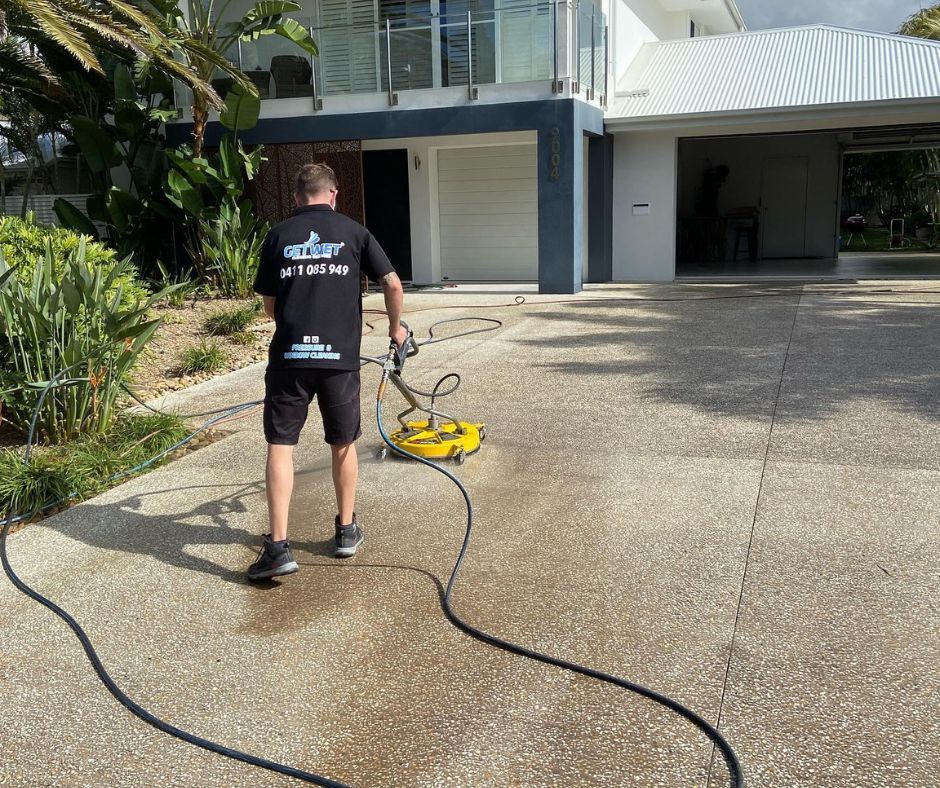
How To Clean a Driveway With a Pressure Washer: The Pro Way
- Site prep & safety: Clear the driveway, sweep or blow loose grit, cover nearby outlets and door seals and set cones/signage if near public footpaths.
- Pretreat the trouble spots: Apply degreaser to oil stains and a mould-killer to green/black growth. Allow proper soaking time to break down the particles of the contaminants so you won’t need to over-pressure the surface.
- Agitate where needed: For stubborn oil or lichen, light agitation (deck brush) helps the pretreat work at lower pressure.
- Surface cleaner pass: Use a rotary surface cleaner (not just a wand) to deliver uniform, streak-free coverage.
- Edge and detail: Use a fan-tip for corners, steps, expansion joints and along the kerb.
- Controlled rinse & runoff management: Rinse contaminants away from doors and vegetation, and avoid washing residue into stormwater.
- Final check & optional sealing: Spot-treat any tyre marks, then, once fully dry, consider a breathable sealer to slow future staining and make maintenance cleans quicker.
Why Hire Professionals for Driveway Pressure Cleaning
Benefits of driveway pressure cleaning done by the experts:
Consistency & Speed
Commercial-grade equipment paired with a surface cleaner produces an even finish in a fraction of the time compared with hardware-store units.
Stain Expertise
Pros know which pretreats lift oil, rust and tyre marls without bleaching or burning the concrete.
Surface Protection
Correct nozzles, standoff distance and method prevent wand marks, etching and damage.
Runoff Compliance
Responsible crews manage wastewater and protect nearby gardens and stormwater drains.
Risks of DIY and Safety Tips
Thinking about how to clean a driveway with a pressure washer? Before you start, note these DIY risks and safety tips so you won’t cause damage to the surface or create hazards.
- Don’t chase results with pressure. If a mark won’t budge, pretreating the stain might be a better solution than turning up the PSI risks etching.
- Skip the turbo nozzle on concrete finishes you care about. It can scar or leave visible lap marks.
- Mind thresholds and expansion joints. Keep water out of garage seals and avoid forcing spray into cracks.
- Test first. Trial a small, inconspicuous patch to confirm pressure, nozzle and detergent choice before scaling up.
How Often Should a Driveway Be Cleaned in the Gold Coast
Plan a professional driveway cleaning once a year as a baseline, especially if your property lies near coastal areas, like the Gold Coast. If your driveway is shaded, sits under trees, or is near the ocean, step that up to twice yearly to keep the surface safe and presentable. If you’re tackling how to clean a driveway with a pressure washer, use these intervals as your guide.
Aim for autumn (after summer downpours) or spring (beginning of the season) so the clean lasts longer. Between deep cleans, sweep regularly, spot-treat oil drips and consider a breathable sealer to slow future staining and make the next wash quicker.
How to Clean a Roof With a Pressure Washer
Roofs are high-risk work zones, so how to clean a roof with a pressure washer safely starts with a caution-first mindset. Most roof cleaning should be handled by trained professionals due to height risks, fragile materials and the chance of voiding manufacturer warranties if the wrong method is used.
Incorrect pressure, poor angles or DIY shortcuts can crack tiles, force water under laps or strip protective coatings, issues that lead to leaks and costly remedial work.
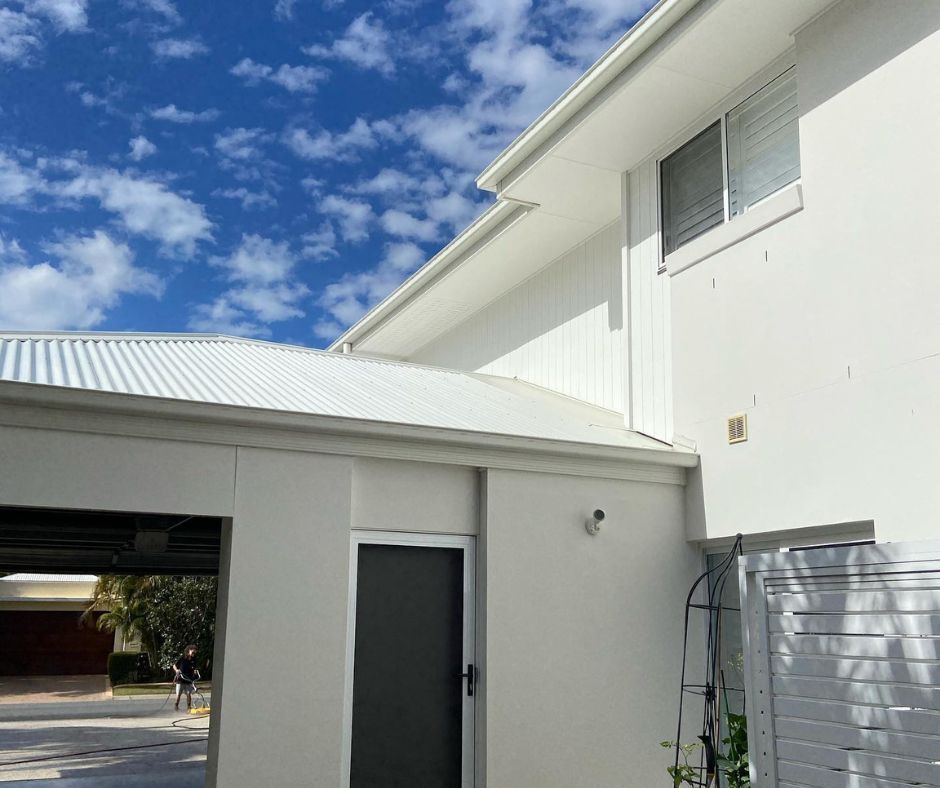
Soft Washing vs Pressure Washing for Roofs
For tiled, metal or Colorbond roofs, professional cleaners opt for soft washing, a controlled, low-pressure rinse paired with roof-safe detergents to dissolve lichen, algae and mould at the root level without damaging the protective coating of the roof. If you’re weighing up how to clean a roof with a pressure washer, this is usually the starting point.
High pressure may still be used in a limited, targeted way (e.g., carefully on specific metal sections). The goal is to clear organic growth and grime, preserve coatings and avoid driving water beneath tiles or sheets.
Roof Types and Pressure Suitability
Tiled roofs (Terracotta/Concrete)
Careful pressure washing for roof tiles is recommended. Tiles are porous and can crack or dislodge under aggressive pressure.
Metal/Colorbond Roofs
Moderate, well-controlled water pressure with the correct angle to protect the factory finish.
Fragile/Ageing Materials
Avoid direct high pressure, specialist cleaning or restorative methods are safer.
Key Professional Techniques
Here’s how professionals approach roof cleaning, especially when you’re planning how to clean a roof with a pressure washer:
- Height safety: Work from scaffold or a certified harness system.
- Appropriate method: Match nozzle and flow to surface. Work top-down with shallow angles to keep water out of joints and penetrations.
- Right Cleaning solutions: Apply roof-safe biocides/inhibitors, then rinse at low pressure to prevent regrowth.
- Detail & drainage: Clear gutters, downpipes and valleys, finish with a controlled rinse.
Why Not DIY?
Roof cleaning might look like a quick weekend job, but it’s far riskier than it seems once you’re up on a wet, pitched surface. Before you grab the washer, think about these DIY risks and hazards that can turn a cheap DIY into an expensive fix.
- Slips and falls: Steep, wet surfaces and unexpected tripping are a dangerous mix without the right gear.
- Structural damage: Over-pressure can loosen tiles, lift ridge caps or damage coatings on metal profiles.
- Water ingress: Poor angles drive water beneath tiles or sheets, wetting insulation and ceiling cavities.
- Warranty issues: Using methods outside manufacturer guidelines can void roof warranties.
Maintenance & Timing
Local conditions on the Gold Coast accelerate the growth of unwanted contaminants and staining, which affects decisions about how to clean a roof with a pressure washer. As a rule of thumb, plan professional roof cleaning every 2–5 years, depending on roof material, shade, nearby trees and salty-air exposure. Between cleans, keep gutters clear and prune overhanging branches to reduce moisture load and debris accumulation.
Can You Clean Decking With a Pressure Washer?
Many homeowners are asking, “Can you clean decking with a pressure washer?”
Yes, only if you follow the right tips on deck pressure washing and knowing when to call in a professional. Different deck materials respond differently, some tolerate a touch more pressure, others demand a soft-wash approach. If done well, this cleaning method restores the colour and preserves the structural integrity of your deck. Used poorly, it leaves patches and a damaged surface.
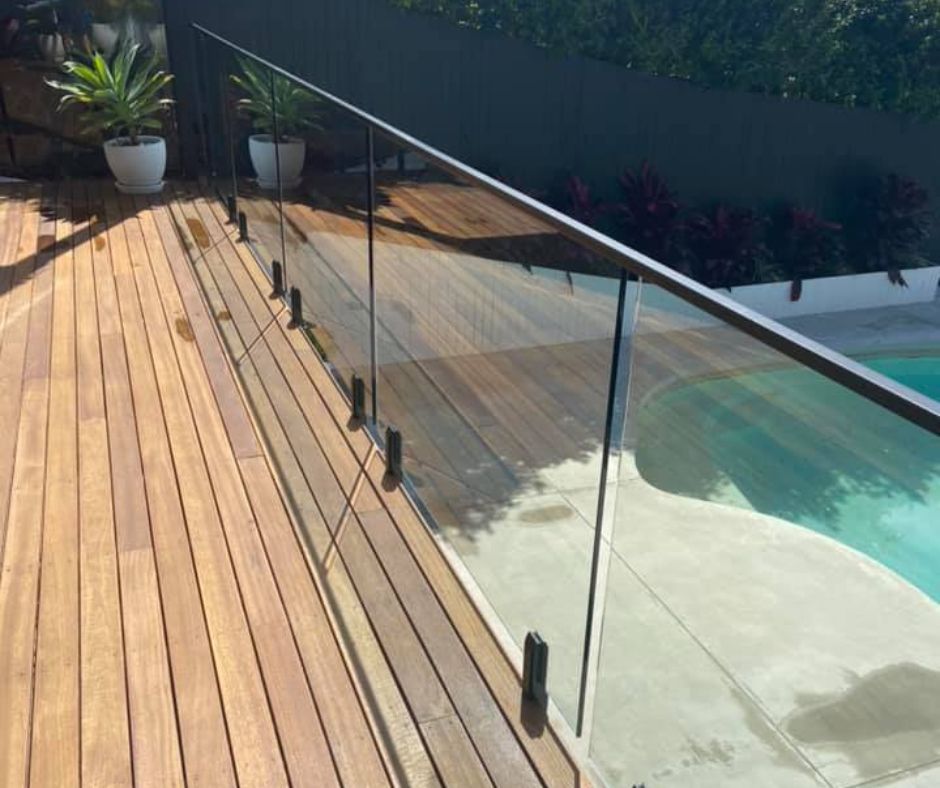
Deck Types That Benefit from Professional Pressure Cleaning
Not all decks behave the same under pressure and can you clean decking with a pressure washer safely depends on the material and method.
Here’s why bringing in a pro is very important.
Treated Pine
Its softer fibres lift easily, so professionals use low pressure and wood-safe detergents to clean without roughing up the surface.
Merbau & Hardwoods
Denser timber can handle a touch more pressure, but it still needs a careful approach.
Composite Decking
Composites can chalk or show patterns if hit too hard and applied with the wrong cleaning agent, so gentle pressure and manufacturer-approved cleaners are a must.
Older or Weathered Decks
Age and wear make boards fragile. Expert cleaners know how to handle these types of deck conditions without causing further deterioration to the material.
Consequences of Getting It Wrong
Push too hard or use the wrong setup and your deck can go from “quick clean” to costly repair. Here’s what that looks like:
Splintered Boards:
Aggressive tips or working too close shreds surface fibres and throws up splinters. These are painful underfoot, hard to sand out cleanly and often leave scars that show through stain or oil.
Raised Grain (“Furring”):
Over-pressure lifts the soft fibres so the surface feels fuzzy and rough. That “hairy” texture drinks too much oil and dries blotchy, usually forcing extra sanding before coating.
Structural Weakening:
Forcing water into end grain and gaps swells boards and loosens fixings. Over time this accelerates decay and movement, especially around stairs and handrails, leading to squeaks, cupping or premature replacement.
Why Professional Cleaning Beats DIY on Deck Pressure Washing
A pro clean isn’t just “more pressure”, it’s smarter prep, safer technique and a better finish. If you’re asking can you clean decking with a pressure washer, here’s why it is not recommended as a weekend DIY.
Uniform Results
Pros match the right cleaning agent to the stain and give it proper time to soak. They then use a deck-specific tool for even, streak-free passes across the whole surface.
Less Damage
Targeted treatments reach into gaps to remove ingrained algae and mildew without tearing up fibres. That means a cleaner deck with less risk of splinters, gouges or water forced into joints.
Less Surface Prep and Rework
A professional deck cleaning leaves a smooth, consistent profile that coatings bond to properly. Your oil or stain lasts longer and you avoid extra sanding and rework.
How to Clean Wooden Decking With a Pressure Washer
Timber looks great, but it’s softer than concrete or brick and can be damaged easily under high pressure. The golden rule in how to clean wooden decking with a pressure washer is the efficient use of the cleaning solution and expert technique and not the brute force of the pressure.
Why Wood Needs a Gentler Approach
When it comes to how to clean wooden decking with a pressure washer, decking and fences are made from materials that can splinter, fur up or gouge if you hit them too hard or too close with a pressure washer. Water can also be driven into joints, causing swelling and slow-drying patches that lead to mould. That’s why experts use techniques with wood-safe detergents so the timber dries evenly without raised or damaged fibres.
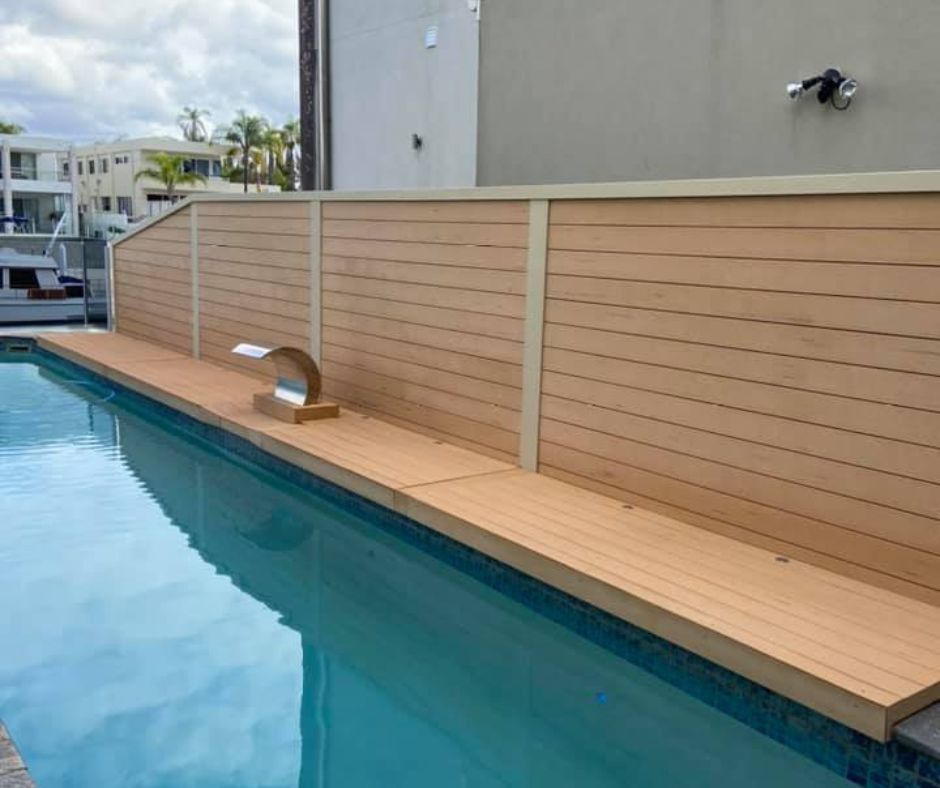
The Pro Method: Soft Wash or Low Pressure
Professionals pair a low-pressure wash for wood with wood-safe cleaners that loosens bio-growth and dirt first, then rinse at low pressure. The operator keeps a safe, consistent distance and moves in smooth, overlapping passes. The aim is an even clean, not a carved, patchy surface.
Benefits of Hiring a Pro for Deck Pressure Cleaning
Hiring a pro means a gentler clean with better results and less risk to your deck, especially if you’re unsure how to clean wooden decking with a pressure washer. Here’s how that pays off:
Preserves timber integrity
Experts use techniques, like soft washing and wood-safe detergents, to lift grime without tearing fibres. This prevents splintering, gouging and raised grain, so boards stay smooth and structurally sound.
Prepares surface for staining, sealing or oiling
A professional clean leaves an even, contaminant-free profile that coatings can bond to. You get more uniform colour, better adhesion and longer-lasting protection with less sanding required.
Eliminates hidden mould and mildew between boards
Professional cleaners treat gaps and edges with targeted detergents, then flush residues from hard-to-reach spots. That cuts regrowth and odours, and helps reduce slippery patches around stairs and handrails.
Best Time for Professional Deck Pressure Cleaning
Choose a window when the weather helps the clean last and the timber dries right through. These two periods give you the best results with the least hassle.
Autumn
It’s the ideal reset after summer heat, humidity, afternoon thunderstorms and dust have loaded the timber. Cooler days and lower UV help the deck dry evenly, so oils and sealers have more time to cure. You’ll head into winter with a clean surface that’s less prone to slimy patches and black mould. That means safer footing through the damp months and less work when spring rolls around.
Spring
This is your freshen-up before outdoor season kicks off and a perfect time to tackle how to clean wooden decking with a pressure washer safely. A spring clean clears winter mould, leaf debris and fine dust. Temperatures are mild and days are longer, which makes scheduling and drying easier with less downtime. It also sets the stage for a quick top-up of sealant if needed, helping boards resist sun and foot traffic damage over summer.
How to Clean a Fence With a Pressure Washer
Fences sit on the front line of your property and collect everything, from airborne dust, cobwebs, mildew, algae, dirt and debris, even sprinkler spots, so they dull fast and make the whole property look tired. Because they’re high-visibility, a dirty fence drags curb appeal more than you think, especially along frontages and side returns people see every day.
Knowing how to clean a fence with a pressure washer helps you lift that buildup safely and restore sharp, even colour so the fence frames your home the way it should.
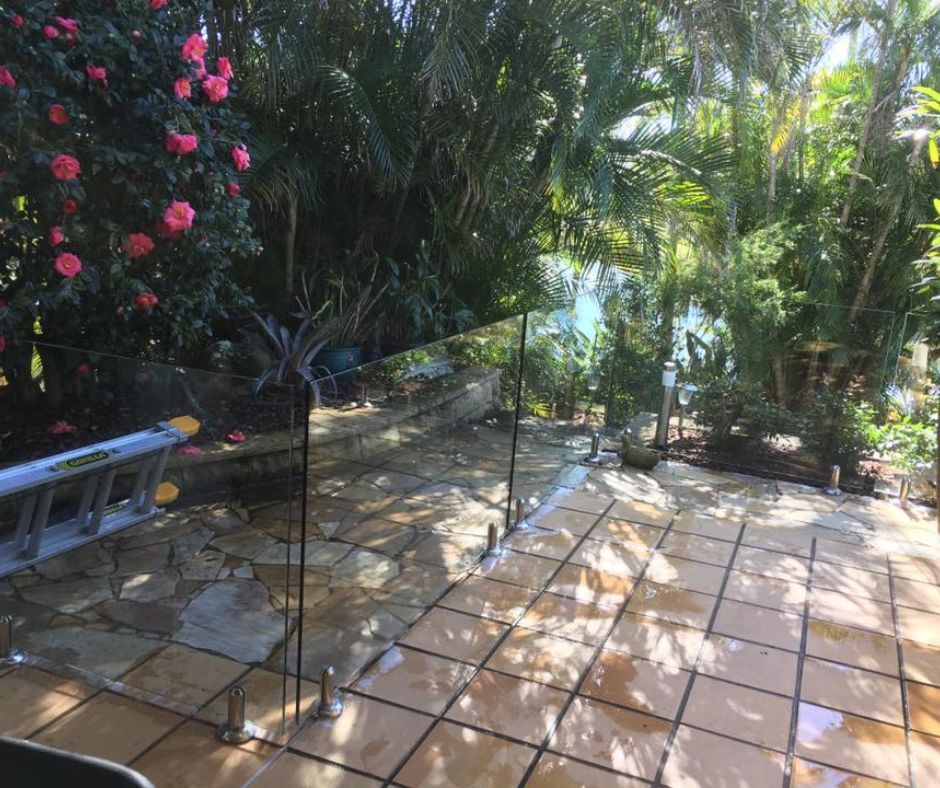
Different Fence Materials and Cleaning Approaches
When planning how to clean a fence with a pressure washer, professionals tailor the approach to the material to protect finishes and get an even result. Here’s how common fence types are handled on the job.
Timber
Timber fences are soft, fibrous and prone to splintering, so they show damage quickly. Pros use low-pressure and wood-safe detergents, work with the grain, avoid joints and end grain, then rinse gently and let the timber dry fully.
Colorbond/Metal
Colorbond and metal panels have factory coatings and laps that can trap residue. Professionals clean at moderate pressure, rinse top-down and avoid harsh chemicals that could mark the finish or react with fasteners.
Vinyl or Composite
Vinyl and composite boards can chalk or show pattern distortion if hit too hard. For how to clean a fence with a pressure washer, pros stand back with a gentle pressure, use manufacturer-approved cleaners and rinse thoroughly so no detergent dries on the surface.
Glass Fences/Balustrades
Pool and patio glass collects dirt and fingerprints, and includes hardware and seals that are sensitive to pressure. Professionals skip direct high pressure washing on edges, seals, clamps and caps, and use soft-wash or purified-water poles with glass-safe solutions for a spot-free finish.
Can You Pressure Clean Petrol Stations?
Yes, petrol station pressure cleaning is possible, but it’s specialist work. Service stations are busy, messy and full of sensitive gear, so every job needs a clear plan for safety, surfaces and wastewater.

Why Service Stations Need Special Care
Safety considerations for service station cleaning must be integrated into every step. Here’s why:
Spills & Residues:
Forecourts collect petrol, grime, food spills and gum that bind to concrete and turn slick when wet. Specialist cleaning uses hot water and the right degreasers, then captures and disposes of the dirty water properly so nothing heads into stormwater.
High Traffic & Hygiene:
Cars and foot traffic never stop, so slip risk and cleanliness matter every day. Professional cleaners may schedule after hours, set cones and signages and deliver comprehensive petrol station pressure cleaning that keeps entry paths, pump bays and shop fronts safe and presentable.
Challenges in Petrol Station Pressure Cleaning
Forecourts need tight control and a clear plan, so petrol station pressure cleaning is never a “quick blast.” Here are the big hurdles and how they’re handled by the experts.
- Safety first: Fuel vapours and ignition risks mean isolating bowsers, using non-sparking gear and setting cones/signage to control traffic. Work is usually done after hours, so cleaning stays safe without disrupting trade.
- Compliance: Dirty water with oil, dirt and fuel can’t go into open bodies of water. Professionals know how to properly dispose of runoff the right way that is compliant with the local council and EPA rules.
Equipment & Cleaning Methods
Here’s what professional cleaners use for petrol station pressure cleaning. Each tool has a clear job and together they deliver a fast, even clean.
Hot Water & Degreasers:
Heat loosens oils, so fuel-safe degreasers lift stains quickly without harming seals or pump coatings.
Surface Cleaners:
Professional service station pressure cleaning uses rotary heads to keep pressure even over big slabs and cut overspray near pumps and the shopfront.
Purified-water pole cleaning:
Spot-free rinsing of shopfront glass and signage leaves no streaks and avoids chemical residue.
Benefits of Professional Petrol Station Pressure Cleaning
A specialist clean pays off where it counts. These are the main benefits of petrol station pressure cleaning you’ll notice straight away.
Safer, cleaner forecourt:
Better grip underfoot and a tidy look that matches your brand, reducing slip risk for customers and staff.
Less disruption:
After-hours scheduling, fast turnaround and a clean handover mean you open on time and with no delays.
Longer-lasting results:
Correct cleaning solutions and right techniques slow down the accumulation of dirt and grime, so maintenance cleans are quicker and cheaper.
Consistent finish across sites:
Every square centimetre gets the same clean, even result at every location for a uniform brand look.
Environmental compliance:
Runoff is disposed of properly, helping you avoid fines and protect nearby waterways.
Insured, trained crews:
Certified teams use the right gear and safety systems, reducing liability and costly mistakes.
Pressure Washer Safety Tips & Considerations
Even a small washer can bite. Use these pressure washer safety tips to keep people, paintwork, and gardens safe while you get the clean you want.
Common Pressure Washing Hazards
Injuries:
The jet can cut skin and eyes. Flying grit and chips can also cause secondary injuries.
Electric shock & falls:
Wet cords, unprotected outlets and slick surfaces raise the risk, especially on steps and ramps.
Property damage:
Over-pressure can etch concrete, lift paint, shred timber fibres or force water into frames and vents.
Chemical exposure:
Mixing or handling chemicals poorly (e.g., bleach with acids or ammonia) can cause toxic fumes and skin/eye irritation.
Carbon monoxide poisoning:
Petrol-powered units used in garages or enclosed spaces can build up dangerous exhaust fumes.
Noise & vibration:
Long runs without hearing protection and breaks can lead to ringing ears and hand fatigue or tingling.
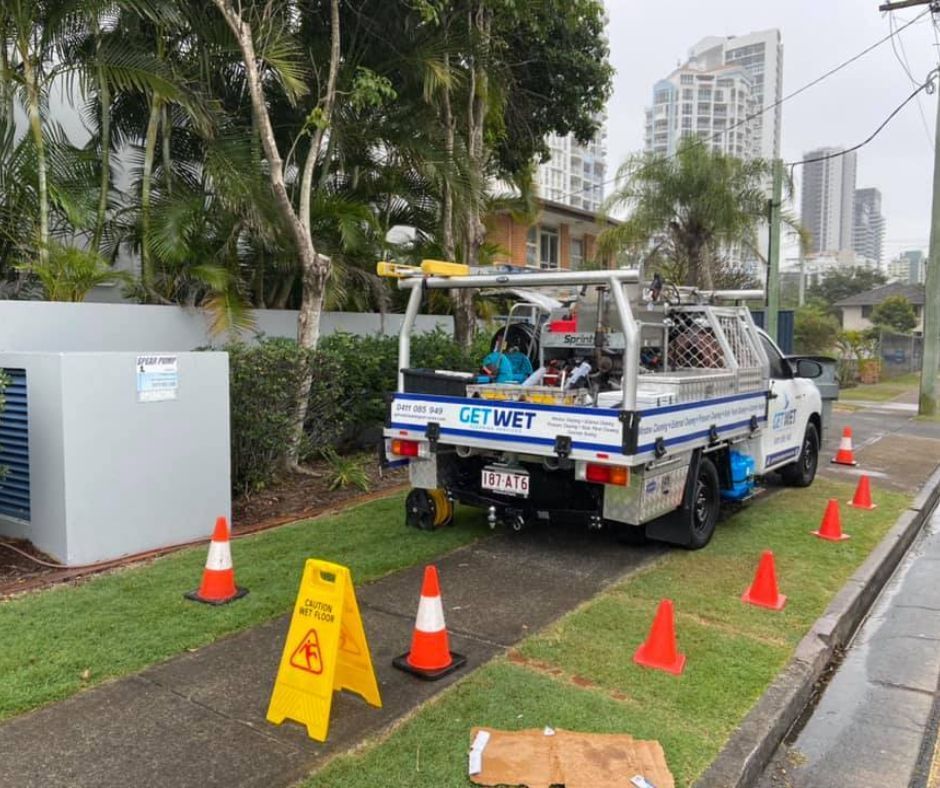
Pressure Washer Safety Tips Before Starting
Run through these quick pressure washer safety tips and checks to stay safe and protect your place.
PPE:
Wear enclosed, grippy boots, long pants, gloves and eye protection to guard against cuts, slips and flying debris.
Power & cords:
Plug into an RCD-protected outlet and keep leads and connections off wet ground to reduce the risk of shock.
Gear check:
Inspect the hose, gun and nozzles for wear and replace any dodgy O-rings or filters before use.
Site scan:
Move cars and furniture, cover outdoor power points and plan where water will run so it doesn’t enter stormwater.
Test patch:
The pressure and nozzle should be tested on a hidden spot first to make sure it won’t damage the surface.
Safe Operating Practices
Professionals follow these pressure washer safety tips and safety precautions to protect people, property and finishes on every job.
- Correct distance & nozzle: Operators start with the right nozzle and maintain steady passes.
- Keep moving: Technicians make slow, overlapping passes to prevent stripes and hot spots and to keep pressure even.
- No ladders with a live washer: Upper levels are reached with extension tools or a height-safe platform, never from ladders with the machine running.
- Mind angles: Spray is kept at a shallow angle and never directed up into cladding joints, weep holes, vents or roof laps to avoid water ingress.
- People & pets: The area is coned and signed, and the spray gun is never pointed at anyone or animals, pressurised or not.
Environmental and Property Protection
Professional cleaners put safeguards in place to protect your home and the environment before starting the pressure washing job.
- Prevent water damage: Door bottoms, timber thresholds and garage seals are shielded and flow is directed away from entries to avoid flooding.
- Protect plants & paint: Landscapes are covered if needed and biodegradable detergents are used at safe dilutions.
- Runoff control: Water is directed where appropriate and contaminated runoff is never allowed into stormwater.
- Hardware & fixtures: Direct spray is avoided for light fittings and outdoor appliances, and overspray on stainless or glass is wiped to prevent spotting.
Tips on Pressure Washing: What "Not" To Do
Pressure cleaners are brilliant but unforgiving. Below are the most common mistakes on the Gold Coast and tips on pressure washing to avoid them.
Common Tips on Pressure Washing that Need to be Avoided
Quick rundown of the big mistakes in pressure washing and why they cause trouble, so you can spot them fast and steer clear.
Too much pressure on delicate surfaces:
High PSI can etch concrete, shred timber fibres and strip paint in seconds.
Skipping surface prep:
Spraying over leaves, dust and cobwebs just smears grime and makes streaks.
Holding the nozzle too close:
Hovering in one spot leaves tiger stripes, gouges and burn marks.
Wrong nozzle or wrong detergent:
Working with the wrong tip or harsh cleaning solutions can wreck coatings and corrode hardware.
Cleaning windows with a pressure washer:
Strong pressure can crack glass or force water past seals into frames.
Spraying upwards under cladding:
Upward spray pushes water behind boards and into cavities where it can’t dry.
Not protecting plants or outlets:
Overspray can drown leaves and vegetation, and outdoor power points can fill with water.
How To Avoid These Mistakes
Pros follow these tips on pressure washing to protect surfaces, speed up the job and keep results consistent.
1. Test first: A small, hidden patch is tested to confirm safe pressure, tip and distance before applying to the whole area.
2. Follow maker guidance: Manufacturer instructions for each surface and cleaner set the limits on pressure, dilution and dwell time.
3. Adjust per surface: Pressure, nozzle and distance are tailored to the material.
4. Plan the sequence: Work runs top-down, so rinse water and loosened grime don’t mess up areas already cleaned.
The Importance of Knowing Mistakes and Tips on Pressure Washing
Understanding the common errors upfront keeps jobs clean, safe and cost-effective.
Prevents Damage
Knowing what not to do stops etching concrete, shredding timber and blowing window or door seals.
Saves Money
Avoiding mistakes cuts out re-cleaning, repainting and repair bills that eat into your budget.
Improves Safety
Fewer errors mean lower risk of slips, electric shock and chemical exposure for people on site.
Delivers a Better Finish
Good practice avoids stripes, patchy colour and water marks so the result looks even and professional.
Protects Compliance and The Environment
Correct methods keep dirty runoff out of stormwater and help you steer clear of fines.
When Should You Call In a Professional
Call a professional for tricky and complicated areas and any job near live power or fragile finishes like render, cladding or old paint. It’s also smart to bring in help for heavy oil staining, rust marks, deep mould, glass balustrades or large areas that need an even, streak-free result, especially if you’ve been trawling tips on pressure washing and want it done right.
Pros handle height safety, choose the right approach for your house washing and manage wastewater so it doesn’t end up in drains. You’ll also get an itemised scope and insurance cover, protecting your surfaces, your warranties and your peace of mind.
Is Bleach Good for Pressure Washing?
Wondering is bleach good for pressure washing? Sometimes, used the right way, on the right jobs and never through the pump. Bleach (sodium hypochlorite) is great at killing mould, algae and bacteria, but it’s also reactive, so appropriate control, dilution and runoff management matter.
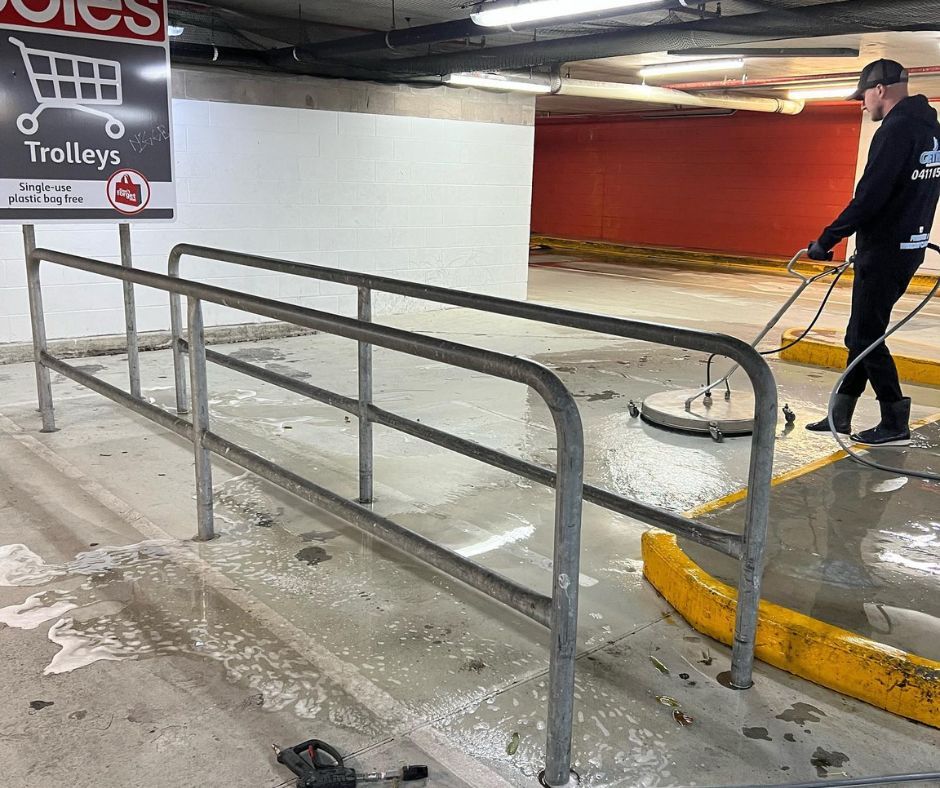
Understanding Bleach in Exterior Cleaning
Sodium hypochlorite is a strong oxidiser (NaOCl) used in liquid form for cleaning and sanitising. Household bleach is simply a dilute solution of sodium hypochlorite, usually around 3–6%, while industrial-grade products can be 10–12.5% and are diluted on site.
For anyone wondering is bleach good for pressure washing, it works by breaking down cell walls and oxidising the organic material that gives stains their colour, so the growth dies and the marks fade. It needs good soaking time and wetting to work well, which is why pros add mild surfactants and keep the surface damp, then rinse thoroughly. Used carelessly, it can bleach dyes and stress plants or metals, so careful dilution and runoff control are very important.
Can You Run Bleach Through a Pressure Washer?
If you’re asking is bleach good for pressure washing, note that using bleach has risks isn’t safe to run through most pressure washer pumps. It’s corrosive and can eat seals, O-rings, hoses and metal parts, leading to leaks, lost pressure and voided warranties, even faster if the mix is strong or left sitting in the machine.
Mixing bleach with the wrong products or heat is risky too. Bleach must never be combined with ammonia or acids, as toxic gases can form. Mixing it with hot water should also be avoided, as it can cause the bleach to decompose, reducing its effectiveness and potentially releasing harmful gases. Professionals only use manufacturer-approved cleaners, with bleach applied as a controlled pre-treatment outside the pump and all equipment thoroughly rinsed afterwards.
When is Bleach Recommended
Situations that call for a professional, controlled bleach pre-treatment:
Heavily colonised surfaces: For mould-rich façades, soffits and eaves, a controlled soft-wash pre-treat kills growth and lifts staining without the need for high pressure.
Roof cleaning: On tile or metal roofs, bleach treatments kill lichen and algae at the roots while protecting tiles, flashing and coatings.
Shaded paths and external stairs: On persistently slippery walkways, bleach cleaning breaks biofilm to restore the grip of the surface.
Pre-paint mildew wash: Before exterior repainting, a bleach-based wash neutralises spores so new coatings bond properly and stay cleaner for longer.
Sanitary zones (bin areas, loading docks): In hygiene-sensitive spots, a controlled application disinfects and reduces odour prior to a thorough rinse.
Best Practices in Pressure Cleaning with Bleach
In commercial pressure cleaning in the Gold Coast, bleach is used only under tight controls to protect people, gear and finishes. The points below outline standard professional best practices in pressure cleaning with bleach.
Pre-treat, don’t pump-feed: Bleach is applied as a pre-treat, allowed proper dwell, then rinsed at low pressure to minimise mechanical stress.
Keep it compatible: Bleach is never mixed with ammonia or acids, and only manufacturer-approved cleaners are used to avoid dangerous reactions and equipment damage.
Protect people, plants and finishes: Crews wear PPE, pre-wet and shield vegetation and sensitive metals, and rinse greenery after treatment to prevent burn and spotting.
Manage runoff and disposal: Runoff is disposed of per local council/EPA requirements, so contaminated water does not enter stormwater.
So… Is Bleach Good For Pressure Washing?
For anyone asking is bleach good for pressure washing, the answer is yes, but only if done under the right conditions. It can be an effective tool in soft washing when applied as a controlled pre-treatment, with correct dilution, dwell time and thorough rinsing. Used this way, it reliably knocks down mould and algae while protecting equipment, coatings and nearby landscaping. Correct use also includes the proper runoff containment and disposal so that no contaminated water enters stormwater.
Used incorrectly, it corrodes pumps and fittings, damages plants, stains metals and contaminates bodies of water through its unmanaged runoff. Always work with certified professionals who use safe concentrations and implement wastewater handling and site preparation.
Key Takeaways
A quick wrap before you put this guide to pressure washing to work. Here are the big lessons to remember:
- Your starting point is a solid guide to pressure washing. Know what the service is, where it works best, and why clean exteriors are part of routine home care. With the basics sorted, you’ll make smarter, safer choices.
- Set a schedule fpr how often you should pressure wash your property. Aim for once or twice a year, with faster cycles for shaded, tree-lined or high-traffic spots, and use seasonal windows (autumn/spring) for longer-lasting results.
- Stack the wins with the benefits of pressure washing. Quick curb-appeal lift, fewer allergens and preventative maintenance that helps paint, timber and concrete last longer, saving money over time.
- Choose method by material (soft wash vs power washing). The right approach avoids damage and gives an even finish.
- Safety and setup drive the result.
Follow pressure washer safety tips and know the risks of DIY approaches.
- Price isn’t the whole story with how much does pressure washing cost in Australia. Costs vary by size, surface, condition, access and method. Compare itemised quotes, ask about runoff management and insurance and book a trusted local pro so the finish looks sharp and lasts.
Ready for a safer, sharper clean?
Book a consultation with Get Wet Cleaning Services and we’ll tailor a plan to your home, so you get lasting results with zero hassle.


